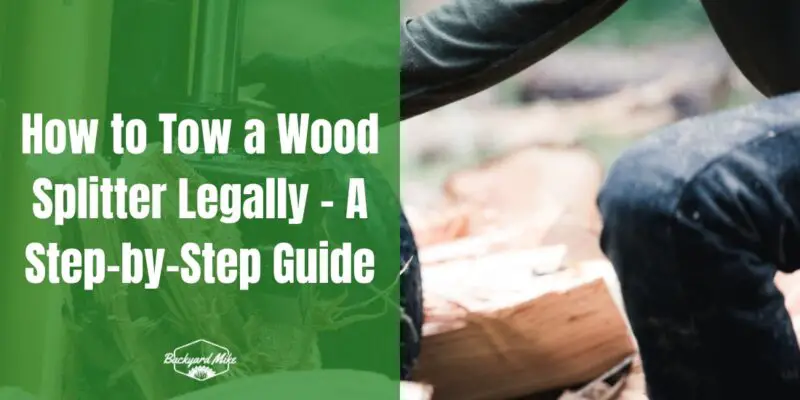To tow a wood splitter legally, first check state requirements for permits and licenses. Verify your vehicle and splitter meet compliance and safety standards. Perform inspections, secure the splitter with safety chains, and confirm proper hitching. Conduct a capacity check for weight, adjust mirrors for visibility, and verify tires are inflated. While towing, pin support legs up and adhere to speed limits. If you follow these steps, you'll discover further detailed guidance.
Key Takeaways
- Verify state requirements for towing wood splitters, as regulations vary and permits might be needed.
- Securely attach the splitter using a matching ball hitch, safety chains, and ensure all safety pins are in place.
- Conduct a capacity check to confirm your vehicle can handle the weight of the splitter.
- Perform regular inspections and ensure compliance with local safety standards, including tire inflation and use of reflective triangles.
- Maintain a safe towing speed of 35-45 mph and avoid adverse weather conditions for safe transport.
Understanding Legal Permits and Licenses
When towing a wood splitter, you must understand the permits and licenses required to do so legally. Regulations and permit types can vary greatly by state, so it's essential to check state requirements before hitting the road. Some states may classify a wood splitter as agricultural equipment, which might alter the permits you need. You could be looking at annual or multiple trip permits, depending on your usage and state laws. Most regions permit towing log splitters on public roads, but you should always verify local regulations prior to towing. For permit applications, you'll generally need vehicle identification numbers and license details. Understanding these requirements not only keeps you compliant but also guarantees you're part of a community that values safety and responsibility. Staying informed helps you belong to this group of conscientious and lawful drivers.
Ensuring Equipment Compliance and Safety Standards
To guarantee your towing setup is safe and compliant with local laws, start by securing the wood splitter to the towing vehicle using appropriate safety chains and hitching mechanisms. Conduct regular safety inspections to verify all equipment meets local equipment regulations. Make sure the towing vehicle and the splitter's tires are properly inflated for peak handling. Here's how you can maintain compliance and safety:
Secure your wood splitter with proper safety chains and hitching for legal and safe towing.
- Check Visibility Aids: Use reflective triangles or safety flags as required by your area.
- Verify Towing Capacity: Confirm the vehicle can handle the splitter's weight.
- Inspect Towing System: Look for wear or damage to prevent failures.
- Observe Speed Limits: Typically, keep speeds between 35-45 mph.
Always adhere to traffic laws and stay prepared for unexpected road conditions. Ensure the log splitter is positioned on flat, even ground to prevent movement during towing and enhance safety.
Preparing and Securing Your Wood Splitter
Before you commence towing your wood splitter, confirm that both the towing vehicle and the splitter are prepared for a safe journey.
Start with a capacity check to ascertain your vehicle can handle the wood splitter's weight. Use a ball hitch that matches the splitter's coupler size for proper coupling. Be aware that local regulations can differ significantly, so it's essential to consult them before starting your journey.
Don't forget to secure safety chains, allowing some slack for easy turning, and maintain proper tire pressure for stability.
Clear visuals are vital, so adjust mirrors or add flags if needed. Secure the splitter to the hitch with safety pins to prevent disconnection, and use tie-downs to limit movement.
Stow all components securely to avoid shifting during transport. This preparation guarantees a smooth and secure towing experience.
Towing Practices and Safety Precautions
Whether you're new to towing or simply need a refresher, understanding towing practices and safety precautions is vital for a seamless experience.
Begin by ensuring your towing techniques comply with local regulations—check licensing, lights, and modifications. Adopting proper safety measures is imperative for preventing mishaps on the road.
Here's a quick guide:
- Support Leg: Pin the support leg in the "UP" position to prevent injury during transit.
- Proper Hitching: Use a correctly sized hitch and attach safety chains with enough slack to accommodate turns.
- Speed and Visibility: Adhere to speed limits, never exceeding 45 mph, and maintain visibility of the log splitter's dimensions. Remember, check attachment of the log splitter to the towing vehicle before moving to ensure a secure connection.
- Weather Conditions: Avoid towing in adverse weather, such as rain or excessive wind, for safety.
Exploring Alternative Transportation Options
When considering alternative transportation options for your wood splitter, it's essential to evaluate the various methods available to best suit your needs. Compact designs, like foldable tables and lightweight materials, make it easier to store and transport. You might find that mounting your log splitter on a tractor or skid-steer can simplify movement and operation. If you prefer towing, trailers with appropriate transport accessories like hydraulic jacks and cable winches can facilitate safe loading and unloading. The TimberOX Summit 30-Ton Log Splitter, with its compact design that folds down to 47 inches, is particularly easy to store and transport. Always use protective covers to shield the splitter from weather conditions and secure it with storage straps. For larger models, delivery services offer convenience by bringing the splitter directly to your door. Assess each option to confirm it aligns with your unique requirements and local regulations.
Frequently Asked Questions
Can I Tow a Wood Splitter With an Electric Vehicle?
You can tow a wood splitter with an electric vehicle, but guarantee the EV's towing capacity meets the requirements. Consider electric vehicle compatibility, plan for range reduction, and check charging infrastructure to stay connected with the community.
How Do Weather Conditions Affect Towing a Wood Splitter?
Did you know 25% of accidents during towing occur in bad weather? Weather impacts are essential; rain, ice, and wind affect towing safety by reducing traction and visibility. Stay vigilant and connected to your community's shared experiences.
What Insurance Coverage Is Needed for Towing a Wood Splitter?
You need liability coverage to meet towing requirements for a wood splitter. Guarantee your policy includes property damage and equipment value coverage. Adhering to these requirements keeps you compliant and part of the responsible towing community.
Are There Any Specific Road Restrictions for Towing Wood Splitters?
Imagine cruising down a sunlit road; you must follow road laws and secure towing permits. Check local regulations for speed limits and equipment requirements, ensuring your wood splitter journey remains smooth and within the community's legal framework.
How Do I Handle Towing a Damaged Wood Splitter?
You should assess the damaged equipment, ensuring towing safety by securing it properly. Choose the right transport method, like a flatbed, and don't hesitate to ask for help. We're in this together, ensuring everyone stays safe.
Conclusion
In summary, when you're ready to tow your wood splitter, make certain you've got the necessary permits and that your equipment meets all safety standards. Secure everything properly to avoid any mishaps on the road. Practice cautious towing methods, watching your speed and being mindful of other drivers. If towing isn't your cup of tea, explore alternative transportation options to move your wood splitter safely. By following these steps, you guarantee a smooth and hassle-free journey.


